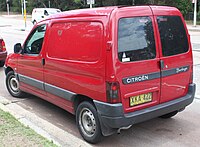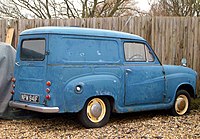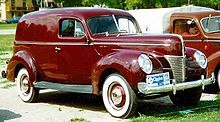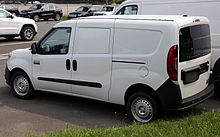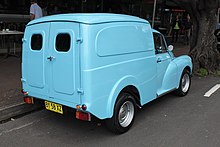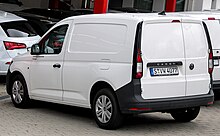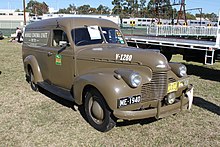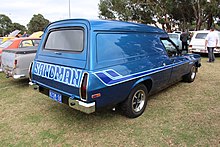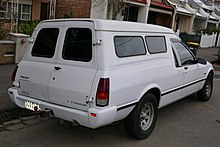Panel van
A panel van, also known as a delivery van (United Kingdom),[1] blind van, car-derived van or sedan delivery (United States), is a small cargo vehicle with a passenger car chassis, typically with a single front bench seat and no side windows behind the B-pillar.[2] Panel vans are smaller than panel trucks or cargo vans, both of which use body-on-frame truck chassis.[1]
As they are derived from passenger cars, the development of panel vans is typically closely linked with the passenger car models upon which they depend. North American panel vans were initially based upon the two-door station wagon models, while Europe's narrower roads dictated that panel vans utilize the smaller donor chassis of subcompact cars in that market. In Australia, panel vans were a development of the ute, a small pickup truck based on a passenger car chassis, e.g. Holden Ute, often using the longer wheelbase of a station wagon chassis.[3][4]
Origins
[edit]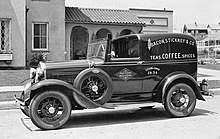
Panel vans were a well-established body type by the end of the 1920s.[5]
Panel vans have experienced divergent evolution in America, Europe, and Australia, as a result of the different passenger car platforms upon which panel vans are based in each region.
North America
[edit]A panel van is often known as a "delivery" or "sedan delivery" in North America. It is an older term that usually only applies to station wagon–based vehicles (sedan deliveries/delivery wagons) such as the Chevrolet Delray and Ford Courier,[6] or pickup-based vans (panel deliveries).[7] Large, boxy unibody vans based on truck platforms (such as the Ford Transit,[8] Ram ProMaster,[9] and Chevrolet Express[10]) as well as smaller unibody vans (like the Ford Transit Connect[11] and Ram Promaster City[12]) are usually referred to as cargo vans or just panel vans. Larger vehicles built on a chassis cab with a custom cargo box are usually called box trucks or moving vans.
In the late 1920s, Ford produced "Town Car Delivery" and "Wood Panel Delivery" as part of the Ford Model A model range.[13] Later Plymouth produced a sedan delivery from 1935 until 1941.[14] Pontiac produced deliveries until 1953 in the U.S. and until 1958 in Canada based on the Pontiac Pathfinder.[15] Sedan delivery models were usually produced in small quantities of 200 or less, for example 449 Canadian Pontiac sedan deliveries were built in 1958.[citation needed]
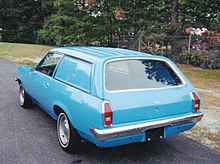
From 1959 on, the sedan delivery was no longer practical; it was phased out in 1960 as a Chevrolet model, so the requisite Chevrolet body was no longer available.[16] With the growing sales of the Volkswagen Type 2 and the introduction of compact vans, sedan deliveries faded from the scene. Chevrolet dropped the body type after 1960, while Ford moved it to the Falcon line-up until 1965.[17]
In the 1970s, Chevrolet and Ford offered subcompact sedan deliveries with the Chevrolet Vega Panel Express and the Ford Pinto Panel Wagon. The Vega Panel Express was introduced in September 1970 and it was Chevy's first sedan delivery in ten years since the final full-size model was offered in 1960.[18] The Vega Panel Express body style accounted for less than 2% of the total Chevrolet Vegas produced during the 1971 through 1975 model years.[17] First-year sales of the Vega Panel Express peaked at 7,800 units and after leveling off to 4,000 units per year, only 1,525 were sold in 1975.[19] The Pontiac Astre Panel, Pontiac's version of the Vega Panel Express, was available in Canada in the 1973–75 model years and in the US for 1975.[15] The Pinto Panel Wagon was introduced in 1976 and was offered in both a commercial and a "factory customized" Pinto Cruising Wagon version that featured a round porthole style window on each side.[17] The Ford Courier name, previously used for Ford sedan delivery vans, began to be used with Ford's import pickup truck line.[20]
In 2002, Chrysler showed a concept car edition of a panel van based on the PT Cruiser at the North American International Auto Show, but it was not manufactured. In 2007 Chevrolet released a panel van version of the HHR, marketed as the HHR Panel.[21]
The small cargo vans currently sold by American manufacturers are from their overseas divisions, for example, the Ford Transit Connect and Ram ProMaster City; however, both vehicles are planned to be discontinued by their respective manufacturers by 2023 due to lackluster sales.[22]
Europe
[edit]European panel vans of the 20th century include the Citroën 2CV Fourgonnette, Citroën H Van, Citroën C15, Ford Escort, Morris Minor, Renault Estafette, SEAT Inca[23] and more recently the Renault Kangoo and the Opel Combo.[24]
From the 1950s onwards, a larger alternative to the panel van was the van (based on a commercial vehicle chassis instead of a passenger car chassis), such as the Volkswagen Type 2, the DKW van and the first-generation Ford Transit in 1965.[25][26][27]
In the United Kingdom, panel vans benefit from having lower taxes than estate cars[28] and do not have the speed restrictions that apply to larger vans.[29] This has given rise to some anomalies. Authorities and dealers are not always certain about what qualifies as a car-derived van.[30] SUVs and crossovers are also popularly turned into light commercial vehicles without rear seats.[31]
Examples of panel vans from the last 30 years are the Renault Kangoo (1997), the Fiat Doblò (2001), Opel Combo (2001), Ford Transit Connect (2002) and the Volkswagen Caddy (2004). They are also purpose-designed to be utilitarian base model MPVs / people carriers, for a range of such vehicles. Since the 1980s most manufacturers have offered light van versions of their small hatchbacks, sharing bodywork with the regular passenger version. These versions have the rear seats removed and may have blanked rear windows, depending on local regulations.
As of 2019, the market consists of the following models and many more:
- Citroën Berlingo
- Dacia Dokker
- Fiat Fiorino
- Fiat Doblò
- Ford Fiesta Sport Van
- Ford Transit Courier
- Ford Transit Custom
- Mercedes-Benz Citan
- Nissan NV200
- Opel/Vauxhall Combo
- Peugeot Partner
- Renault Kangoo
- Toyota ProAce City
- Volkswagen Caddy
Australia
[edit]The first Holden panel van produced in Australia was the FJ Holden, which was released in December 1953,[32] although many manufacturers offered panel vans in their range prior to this.[33][34][35][36][37][38][39][40] Like many Australian panel vans, it was based on a corresponding ute and station wagon models. In May 1961, Ford Australia released a panel van version of the XK Falcon, marketed as the "sedan delivery" body style.[41] The first panel van by Chrysler Valiant was part of the CL Valiant model range and was introduced in April 1977.[42]
Panel vans' combination of cargo space and customisable interior in a relatively compact vehicle made them attractive to painters, electricians, general labourers and film crews.[43] Australian police forces also used panel vans (nicknamed "divvy vans" or "paddywagons").[44]
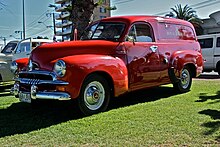
Early Australian panel vans used swing-down and -up tailgates and a standard roof height, indicative of their ute and station wagon/sedan delivery origins. In the mid 60s first Holden, then Ford introduced unique rooflines to their panelvan models. These were higher than the previous stagion wagon based roof, giving greater cargo space and functionality. In the early 70s, Ford introduced horizontally opening rear doors (nicknamed "barn doors").
By the early 1970s, when panel vans were in decline in America, they had become cultural icons in Australia.[45] The most popular model was the Holden Sandman, which was marketed to surfing lifestyle.[46][47] The first Sandman was built in small quantities in 1974 in the HQ model range, but the model's popularity greatly increased in the subsequent HJ generation, which was released in October 1974.[48][49] In the 1979 movie Mad Max, a modified 1975 HJ Sandman model was one of the vehicles driven by the lead character (played by Mel Gibson).[50]
Ford's competitor to the Sandman was the Surferoo, which was introduced into the XB Falcon model range in 1973.[51][52] In 1977, the Surferoo was replaced by the more popular Sundowner, in the XC Falcon range.[48][46] The traditional tailgate style doors were also reintroduced as an option with the XC range.
In 1976, Chrysler released a similar model called the Drifter, which was part of the Chrysler CL Valiant product range. The Drifter ceased production in 1978.
Younger drivers were especially attracted to panel vans, not least because of the ease with which a mattress could be installed within the cargo bay. Consequently, panel vans also attracted nicknames such as "sin bins," and "shaggin' wagons".[53][54] During the 1970s many Australian panel van owners took to applying airbrush mural art to the sides of their vans, paralleling a similar trend in America.[55] Along with Volkswagen Kombi micro-busses, panel vans were popular with surfers, who could sleep in the cargo bay while carrying surfboards on the roof.
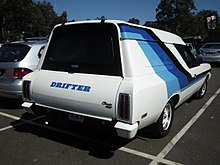
By the end of 1979, the Sandman had largely lost its place in the contemporary Australian youth culture – order figures were down and many of the vehicles were now being sold with the stripes and tailgate logos deleted. The final Sandman was in the Holden HZ series and featured V8 engines only, along with a four-headlight grille and under bumper front spoiler. In 1979, a basic HZ Holden panel van was priced at A$6,076, with the Sandman option package an additional A$1,700. If a buyer selected every Sandman extra, which would cost in excess of 50% more than a basic HZ panel van, Holden would include a velvet mattress with the Holden logo embroidered. The Sandman ute and panel van were phased out in October 1979, with the end of the HZ series.[56]
Panel vans generally declined in popularity through the 1980s. Holden's last panel van, the WB, ceased production in 1984.[57] Ford was the last manufacturer of Australian panel vans, until production of the XH Falcon, ceased in 1999.
In 2000, Holden unveiled a retro-styled Sandman show car based on the Holden VU Ute. While this Sandman was never released, a canopy or "camper shell" featuring the same styling was made available as an A$6,150 accessory for Holden utes from 2003 through 2006. Installation was complicated, however, and the rear window and cab wall of the ute were retained, preventing movement between the cargo bay and the passenger cab as was possible in purpose-built panel vans.[58]
See also
[edit]- Car body style
- Coupé utility
- Light commercial vehicle
- Panel truck, built on a truck chassis, a panel truck is usually larger than a panel van
- Pickup truck
Explanatory notes
[edit]- 1.^ The Holden panel van is an exception to the unibody rule of panel vans; however, it is not excluded as its ladder chassis is an adaptation of a unibody passenger car design, and size, towing and ride height classifications to suit.
References
[edit]- ^ Collins English Dictionary and Chamber's English Dictionary
- ^ "Car-derived vans and dual purpose vehicles". UK government. Retrieved 18 February 2018.
- ^ "Another look at sedan deliveries". Mac's Motor City Garage. 12 September 2013. Retrieved 18 February 2018.
- ^ Adams, Keith (25 September 2011). "Commercials : Car derived vans/pick-ups – AROnline". AROnline. Retrieved 18 February 2018.
- ^ "What is a Panel Van?". Wisegeek. Retrieved 18 June 2018.
- ^ "1950 Chevrolet Sedan Delivery Advertisement | A rare ad from…". Flickr. 26 July 2009.
- ^ "1964 Chevrolet Panel Delivery | Alden Jewell". Flickr. 19 January 2015.
- ^ "2020 Ford Transit Cargo Van". Ford Motor Corporation. Archived from the original on 8 August 2020.
- ^ "2020 Ram ProMaster - Commercial Cargo Van For Any Job". US: RAM Trucks.
- ^ "2020 Chevy Express Cargo Van | Custom Fit for Your Business".
- ^ "2020 Ford Transit Connect Cargo Van". Ford Motor Corporation.
- ^ "2020 Ram ProMaster City - Cargo, Work & Passenger Van". RAM Trucks.
- ^ "Putting on the Ritz – The Model A Ford Town Car Sedan Delivery | The Old Motor". theoldmotor.com. 31 July 2014. Retrieved 18 February 2018.
- ^ Benjaminson., Jim. "Plymouth vans and delivery trucks". allpar.com. Retrieved 18 February 2018.
- ^ a b Jewell, Alden (25 November 2014). "The Sedan Delivery". aldenjewell.com. Retrieved 18 February 2018.
- ^ 1960–61 Chevrolet Full-Line Truck brochures
- ^ a b c Halter, Tom (9 July 2017). "Automotive History: The Sedan Delivery". curbsideclassic.com. Retrieved 18 February 2018.
- ^ "1971–1975 Chevrolet Vega Panel Express and the 1973–1975 Pontiac Astre Panel". Old Cars Canada. 13 June 2015. Retrieved 9 March 2018.
- ^ h-body.org
- ^ Martin, Murilee (3 November 2011). "Junkyard Find: 1972 Ford Courier". The Truth About Cars. Retrieved 9 March 2018.
- ^ Nunez, Alex (6 October 2006). "Chevy introduces HHR Panel". Autoblog. Retrieved 9 March 2018.
- ^ McIntosh, Jil (1 September 2022). "Rumours of Ram ProMaster City's demise marks end of small-van market". Driving.ca. Retrieved 13 September 2022.
- ^ Dutch, Johannes (24 July 2015). "CC Global: Compact European Panel Vans – Their Evolution in the Past 25 Years". Curbside Classic. Retrieved 4 March 2018.
- ^ Axon, Gary (2 March 2018). "Axon's Automotive Anorak: Attack of the vans". goodwood.com. Retrieved 4 March 2018.
- ^ Turla, Antanas (13 June 2017). "VW Type 2 – The Most Important Van in the History?". DriveTribe. Retrieved 4 March 2018.
- ^ Niedermeyer, Paul (29 March 2010). "The Mother Of All Modern Minivans: 1949 DKW Schnellaster – The Truth About Cars". The Truth About Cars. Retrieved 4 March 2018.
- ^ Moss, Darren (30 July 2013). "History of the Ford Transit: picture special". UK: Autocar. Retrieved 4 March 2018.
- ^ "What is a car, commercial vehicle or motor home for VAT". HM Revenue & Customs (HMRC).
- ^ "Speed limits and speeding". direct.gov.uk.
- ^ "Confusion over van speed limits". Fleet News. UK. 28 July 2005. Retrieved 4 March 2018.
- ^ Chin, Joshua (27 July 2020). "The Wonderful World Of The Commercial SUV Market". Automacha. Malaysia. Archived from the original on 4 August 2020.
- ^ "Aussie Classic: 1951–1957 FX & FJ Holden Utes & Vans". Truck Jungle. Retrieved 24 October 2018.
- ^ "MORRIS 8 PANEL VAN". 26 October 1936. p. 19 – via Trove.
- ^ "NEW PANEL VAN". Farmer and Settler. 17 September 1936. p. 12 – via Trove.
- ^ "A CHEVROLET PANEL VAN FOR 1936". Farmer and Settler. 13 February 1936. p. 10 – via Trove.
- ^ "Panel Utility Van On Willys Chassis - The Herald (Melbourne, Vic. : 1861 - 1954) - 16 Mar 1936". Herald. 16 March 1936.
- ^ "BEDFORD PANEL VAN - SMART TOWN JOB Big Production Plans Announced GREAT VALUE - Truth (Brisbane, Qld. : 1900 - 1954) - 15 Apr 1934". Truth. 15 April 1934.
- ^ "STANDARD LIGHT VAN". Truth. 7 June 1936. p. 11 – via Trove.
- ^ "FORD PANEL VAN - The Herald (Melbourne, Vic. : 1861 - 1954) - 28 Mar 1938". Herald. 28 March 1938.
- ^ "INTERNATIONAL PANEL VAN". Herald. 8 August 1938. p. 17 – via Trove.
- ^ Bushby, A. C. (1989). The Australian Ford Falcon. ISBN 0-7316-3621-X.
- ^ "Valiant CL Technical Specifications". Unique Cars and Parts. Australia. Retrieved 24 October 2018.
- ^ "Model FJ Holden panel van commemorates newsreel era at National Film and Sound Archive". Australia: ABC News. 20 August 2018. Retrieved 24 October 2018.
- ^ "Aussie Panel Van: Ford Falcon XD Police Divvy Van". Doogies Diecast. 21 June 2018. Retrieved 24 October 2018.
- ^ Huynh, Mike (20 January 2015). "10 Most Iconic Australian Cars in Aussie Culture". D'MARGE. Retrieved 24 February 2018.
- ^ a b "Holden Sandman turns 40". Cars Guide. Australia. Retrieved 25 October 2018.
- ^ "Australian Vanning History- Part 1" (PDF). Vanning. Australia. Retrieved 26 October 2018.
- ^ a b "Holden Sandman review". Trade Unique Cars. Australia. 21 March 2014. Retrieved 25 October 2018.
- ^ "Welcome the new HJ; a fresh face". All About Holdens. Australia. Retrieved 25 October 2018.
- ^ "1979 "Mad Max"/ 1975 Holden Sandman HJ – Best Movie Cars". Best Movie Cars. 25 April 2017. Retrieved 24 February 2018.
- ^ "History of the Ford Falcon XB". Which Car. Australia. 13 January 2018. Retrieved 25 October 2018.
- ^ "Ford vs. Holden". E-Motor. Australia. Retrieved 25 October 2018.
- ^ Byrne, Bob (18 October 2014). "The Shaggin' Wagon – Cars From Our Youth". Adelaide Remember When. Australia. Retrieved 24 February 2018.
- ^ "Living in the 70's – Panel Vans". Australia: ABC. Retrieved 24 October 2018.
- ^ King, Poppy (12 April 2002). "Sex and art on wheels". The Age. Australia. Retrieved 24 February 2018.
- ^ "1977 to 1979 The HZ Series". All About Holdens. Australia. Archived from the original on 4 June 2019. Retrieved 26 October 2018.
- ^ "1980 to 1984 The WB Series". All About Holdens. Australia. Retrieved 26 October 2018.
- ^ "History of the Sandman". Rare Spares. Australia. Archived from the original on 30 March 2020. Retrieved 26 October 2018.

